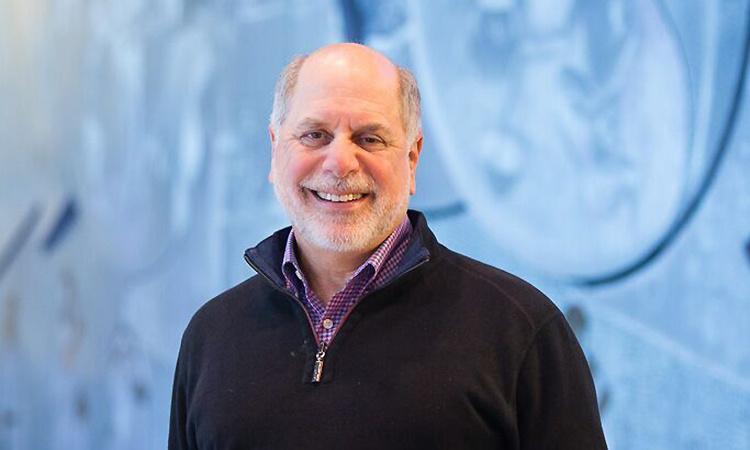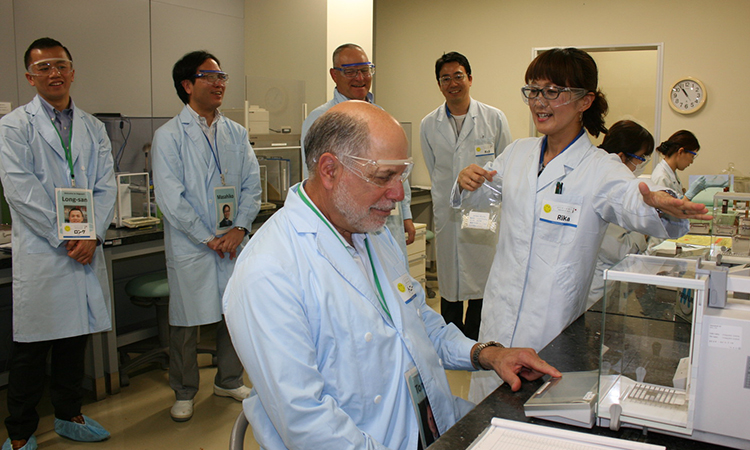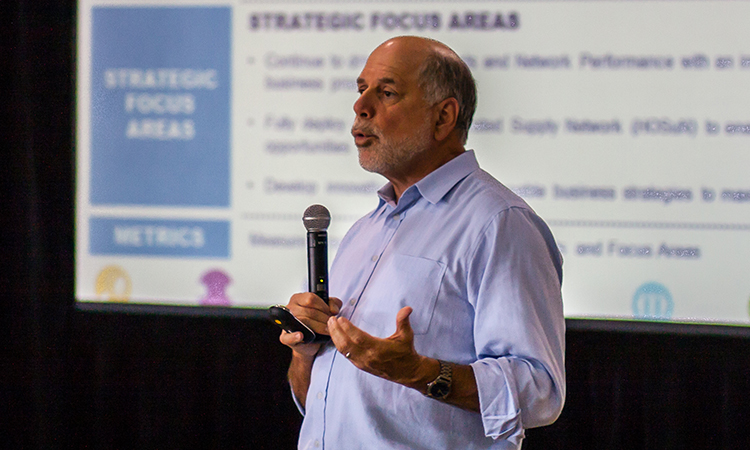A Matter of Well-Being: A Profile of Anthony Maddaluna

Maintaining a robust supply of high-quality medicine is neither easy nor inexpensive. It depends on reliable processes, a secure supply chain, and a skilled workforce. Yet even when good medicines exist to treat an illness, delivery of these drugs could be disrupted by quality challenges, breaks in the supply of active pharmaceutical ingredients (APIs), or corporate decisions about where and when to allocate resources.
There are few who understand this as well as Anthony Maddaluna, whose career at Pfizer Inc. spanned four decades. He announced his retirement in December 2016, when he stepped down as executive vice president of Pfizer; his transition will be complete at the end of June.

The Well Being Industry
In 1975, when Maddaluna started his career as a chemical engineer with Pfizer in East St. Louis, Missouri, Wozniak and Jobs had just developed the Apple 1 prototype, the Vietnam War had ended, and disco, Rubik’s Cubes, and pet rocks were the latest fads. He worked in the company’s minerals, pigments, and metals division before holding engineering positions at a plant in Adams, Massachusetts. He moved into the pharmaceuticals division in 1983, and stayed.
Maddaluna spent time considering what his life’s purpose was. It was founded on his desire to persistently make a profound positive difference, in both his personal and professional lives. “Once I did that exercise, I realized that by being a part of the industry, I could make a real difference in people’s lives. I enjoyed my work, found it fulfilling, and feel that I was able to contribute positively because what I was doing aligned and resonated with my purpose.”
A well-functioning society depends on what Maddaluna likes to call “the well-being industry.” “All of us at some point rely on the pharmaceutical industry,” said Maddaluna. “If we’re not doing our job, it means you’re not getting to work, you’re not getting to the grocery store, you’re not driving your children to school. We are fundamental to society.”
Early Career
Maddaluna received his BS in chemical engineering from Northeastern University, and earned an MBA in management and organization development from Southern Illinois University. He had co-op assignments at the US Environmental Protection Agency and Johnson & Johnson prior to joining Pfizer.
Despite his academic training as a chemical engineer—an education he recommends for the way it teaches problem-solving skills—he knew early on that he wanted to move into management, and work directly with people. This was reinforced when he learned a valuable lesson as a co-op student at Johnson amp; Johnson during his last plant rotation as a maintenance supervisor in the Band-Aid production area. Beyond the technology and the costing he learned, he saw that the key to a plant’s success lay in its people and their relationships.
“I quickly discovered that the most important people were those who were packing Band-Aids by hand and operating the machines, because they were closest to the process and first to identify a problem,” he remembered. “They were the real experts.”
It showed him that quality and reliable supply stem from nurturing good relationships with people; this knowledge has had a lasting impact on the way he has worked ever since.
After East St. Louis and Adams, he moved on to what was supposed to be a three-month assignment at a plant in Terre Haute, Indiana, working on a plant start-up. It turned into an 11-year assignment during which he met his wife Brenda. Maddaluna became the plant manager in 1991. He was also instrumental in crafting the values of the plant, which focused on people, relationships, and internal culture. These became the basis for the values and vision that Pfizer Manufacturing developed in the 1990s.
In 1994, he moved to Puerto Rico as the general manager of Pfizer’s fully integrated high-volume Barceloneta plant, which produced APIs as well as finished drug and packaged drug products, and shipped them to the United States. It was the company’s largest factory, responsible for end-to-end production of products that helped grow the company—including Procardia XL, Norvasc, Diflucan, Zithromax, Zoloft, and Viagra.

An Evolving Supply Chain
Maddaluna has seen incredible changes in the industry over the course of his career, perhaps nowhere greater than in the supply chain he has overseen since his time as general manager in Puerto Rico. Since the 1990s Pfizer has grown from three plants in the United States and a few in Europe to its current slate of more than 60 plants around the world, with the greatest footprint in the United States “We now have around 30,000 SKUs,” he said. “Different products have different supply chains, but they are global, unlike in Puerto Rico, where everything was made from beginning to end.”
The push for low-cost generic products like anti-infectives globalized manufacturing and drove the decision to outsource. “Virtually all of the anti-infective API manufacturing is done outside of the United States. That part of the industry was pushed out because the products became competitive, the supply chain became more complex, and regulatory requirements drove investments that could not be justified.”
Difficulties of a complex supply chain included supplier issues, and the challenges of being efficient. Despite this, the fact that a lot of products are now derived from a combination of internal and external supply offers an opportunity for innovations in supply chain design.
Maddaluna helped change the way Pfizer approached its basic supply chain organizational structure.
Managing Complex Supply Chains
Maddaluna helped change the way Pfizer approached its basic supply chain organizational structure. Previously, some plants combined operational units with customer-facing roles. Over the last several years, Maddaluna oversaw the separation of the two. Within the customer interface, the company added a product portfolio management group with an end-to-end view of products.
“We’ve taken the supply chain piece and rolled it into Pfizer Global Supply where before it wasn’t fully integrated,” he explained. His team also enacted a corporate initiative to institute an enterprise resource planning system, which provides a common database for data pulled from different levels. Pfizer Global Supply does demand planning for all the businesses and has market representatives in 78 countries.
“If you look at the supply chain, there’s planning the products, the demand planning, the scheduling, all the flow of information through the supply chain, and matching up this information with the flow of the manufacturing process,” he said. This means managers are now able to take an end-to-end view of the entire supply chain process, and incorporate activities that used to be done at plants into the overall network. Control towers manage distribution from plants to its distribution centers. Now the company is creating designated supply hubs around the world instead of doing supply planning in all of its operations.
“We’re aiming for a tracking system similar to what big retailers have,” Maddaluna said. “Imagine the ultimate result: A doctor pulls a vaccine out of a fridge, and a smart unit sends a signal to us via the internet telling us we need to replace that product.”
Serialization And Security
Currently, high-volume older products such as statins and blood pressure meds can be tracked with the systems that are in place. It’s the low-volume personalized products such as gene therapies and biologics for which delivery must evolve.
Pfizer piloted radio-frequency identification (RFID) of products eight years ago in partnership with the US FDA and others, placing an RFID antenna on each bottle of Viagra. They found the cost and robustness problematic, however.
“The technology behind the RFID labels wasn’t quite there,” he said. “I’m not saying it won’t come back, maybe [it will] with impregnated chips, but as an industry, we decided that the 2D bar code was the way we wanted to go.”
This serialization is now either in place or being mandated by regulators around the world. Two examples are the US Drug Supply Chain Security Act, which requires the creation of an electronic system to identify and trace drugs to the level of individual packages,1 and the European Union’s Falsified Medicines Directive 2011/62/EU, which will require a track-and-trace system with 2D bar codes and anti-tampering devices on all products by February 2019.2
“With track and trace, every product is now serialized with a 2D bar code,” he said. “We can match any unit with the case and the pallet it came from.”
This move to serialization is fundamental, not only to maximize the efficiency of global supply chain logistics, but to prevent falsified medicines and theft. “With serialization in place, if a product comes out of the supply chain, it won’t get back in,” Maddaluna said. “This includes product that has been sent to a distributor or a pharmacy or has been stolen.”
Other technology changes that will affect the supply chain include the block chain, which can act as a secure electronic ledger of a product’s movements; the Internet of Things, which connects equipment across a firm’s network of facilities and, probably, individual product packages; robots to automate production and delivery; drones used in delivery; and 3D printing.3 All of these increase security vulnerabilities.
- 1US Food and Drug Administration. “Drug Supply Chain Security Act (DSCSA).” http://www.fda.gov/Drugs/DrugSafety/DrugIntegrityandSupplyChainSecurity/DrugSupplyChainSecurityAct/default.htm
- 2European Commission. “Medicinal Products for Human Use.” https://ec.europa.eu/health/human-use/falsified_medicines_en
- 3PwC. Health Research Institute. “Top Health Industry Issues of 2017.” http://www.pwc.com/us/en/health-industries/top-health-industry-issues.html

Supply Chain And Drug Shortages
Drug shortages are an ongoing problem, particularly for generic injectables and a significant number of chemotherapeutics; there were 120 new occurrences in the first three quarters of 2016.4 ISPE conducted a survey of its membership and found that compliance, together with manufacturing and product quality issues, represented the single most important factor leading to drug shortages.5 ,6
The Pew Charitable Trusts and ISPE recently published findings from a survey of manufacturers of sterile injectables in the United States; the survey explored factors other than quality that lead to drug shortages.6 One of these factors is supply chain management, which includes inventory, demand planning, and forecasting to match predicted demand with projected inventory.
The study found that while companies use “business continuity elements” (e.g., safety stock of raw materials and finished goods, and more than one supplier for a product), they did not use them across their product lines. Instead, manufacturers based their contingency plans on the type of product, taking into account the investment required, the effect of shortages on patients, and the complexity of the manufacturing process.6
“Most times the best course of action is to slow down the conversation, get the big picture, and really understand before you do anything.”
Maddaluna noted that there are products for which it’s hard to make a good business case—antibiotics is one example. Historically, these were low-cost products; when many firms entered the market, businesses couldn’t survive because world prices went down. “To address this issue in light of the fact there are only one or two players making APIs for a particular anti-infective outside the United States, you need to sustain an investment in equipment and process of these older products,” he said.
He said Pfizer has been approached at times by the FDA, asking if it could make a product it no longer does. “We’ve brought products that are on the supply shortage list back because it’s good for patients, and it’s good for the business.”
Maddaluna believes the public should be reminded of this kind of activity. “Think of all the advances we’ve made. I believe that cancer, for my kids’ or grandkids’ generation, will be treated like a chronic disease. It is this type of difference that ties back to my purpose.”
A Passion For Excellence
Maddaluna is most proud of the last job he had, setting up Pfizer GlobalSupply Transformation. It has seven work streams, including digital, supply chain, and organizational efficiency, each with its own metrics. The program is the embodiment of what he believes is required for an organization that aspires to become world class.
“‘World class’ to me means that we’re doing things impeccably,” he said. “It means our customer gets the product, that there are no shortages. It works because of where we’re making it and how we’re costing production.”Maddaluna knows that “world class” is not easy to measure, despite the metrics, “but you know when you achieve it.”
He is gratified with the transformation underway, and not only because it fosters a self-sustaining organization that will continue to help patients. He believes he and his group draw upon a strong history of manufacturing expertise on which the Pfizer executive team and entire organization can build upon as new businesses are integrated into the company’s supply chain network.
“This transformation effort is for our patients, certainly, and it’s for the organization. But where it’s most important, to me at least, is for our 30,000 colleagues. As you move towards becoming world class, it becomes easier for them to get their work done. They get it right the first time. You’re more engaged, you feel ownership. That resonates if we show our colleagues the material results and how it affects them.”
Although Kirsten Lund-Jurgensen succeeds Maddaluna, he will remain active in the pharmaceutical industry as a member of the board of directors of Albany Molecular Research Inc. He also represents Pfizer on the National Association of Manufacturers (NAM) and is a member of the NAM executive committee.
In addition, he has some parting advice for young leaders in his industry: “Most times the best course of action is to slow down the conversation, get the big picture, and really understand before you do anything. When you’re younger, you’re prone to action and want to solve problems.”
Maddaluna leaves Pfizer knowing that his focus has always been on harmonizing the values of the company with his personal values, which revolve around his relationships with his colleagues and delivering helpful products to patients.
“No matter how automated you get, I don’t think robots are going to replace personal and corporate values,” he said. “Our colleagues understanding the importance of what they do each and every day and the relationships within our network and industry are key to delivering to patients and to the well-being industry we are in.”
- 4Fotheringham, S. “The Catastrophe of Drug Shortages in Pediatric Oncology.” Pharmaceutical Engineering 37, no. 1 (January-February 2017): 33–34. https://ispe.org/pharmaceutical-engineering/january-february-2017/catastrophe-drug-shortages-pediatric-oncology
- 5US Food and Drug Administration. Drug Shortages. “Frequently Asked Questions about Drug Shortages.” http://www.fda.gov/Drugs/DrugSafety/DrugShortages/ucm050796.htm#q2
- 6 a b c The Pew Charitable Trusts. “Drug Shortages.” January 10, 2017. http://www.pewtrusts.org/en/research-and-analysis/reports/2017/01/drug-shortages


